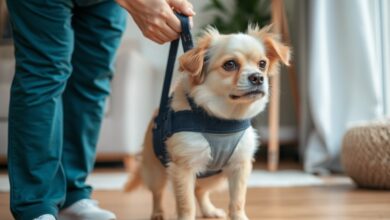How Muscular Should a Puppy Be? A Guide to Healthy Growth

When it comes to puppies, understanding their growth and development is crucial for ensuring they grow up healthy and strong. One common concern among dog owners is how muscular their puppies should be. This guide will help you navigate the stages of puppy growth, the importance of a balanced diet, and the best exercises to promote healthy muscle development. Knowing what to expect can help you provide the best care for your furry friend as they transition from puppyhood to adulthood.
Key Takeaways
- Puppies grow at different rates, and muscle building should not be forced before they are two years old.
- A balanced diet rich in protein is essential for healthy muscle development in puppies.
- Exercise is important, but rest days are necessary for muscle recovery.
- Certain breeds, like Rottweilers and Boxers, naturally build muscle more easily than others.
- Regular vet check-ups can help assess your puppy’s muscle condition and overall health.
1. Puppy Growth Stages
Puppies go through several important growth stages as they develop from tiny newborns into strong adult dogs. Understanding these stages helps ensure they receive the right care and nutrition. Here’s a brief overview of the key stages:
0 – 3 Weeks: Neonatal Stage
- Birth: Puppies are born blind and deaf, relying on their mother for warmth and nutrition.
- Development: They should weigh about 1-5% of their expected adult weight at birth.
- Health: Regular vet check-ups are crucial to monitor their well-being.
4 – 8 Weeks: Transitional Stage
- Behavior: Puppies start to play and interact with their siblings, learning social skills.
- Development: Their senses begin to function, and they start to explore their environment.
- Nutrition: This is when weaning begins, and they start showing interest in solid food.
8 Weeks and Beyond: Socialization Stage
- Behavior: This is a critical time for training and socialization, shaping their future behavior.
- Development: Most muscle growth occurs between six to nine months, depending on the breed.
- Health: Establishing a routine for exercise and vet visits is essential for their growth.
| Stage | Key Focus Areas |
|---|---|
| 0 – 3 Weeks | Nutrition, Health, Development |
| 4 – 8 Weeks | Socialization, Behavior, Weaning |
| 8 Weeks + | Training, Muscle Growth, Routine Health |
Understanding these stages is essential for effective training and nurturing throughout their life. Puppy growth is a journey that requires attention and care.
2. Healthy Puppy Diet
A balanced diet is crucial for your puppy’s growth and muscle development. Puppies need the right mix of nutrients to grow strong and healthy. Here are some key points to consider:
Essential Nutrients
- Proteins: Vital for muscle growth. Look for high-quality meat sources.
- Fats: Provide energy and support skin and coat health.
- Carbohydrates: Offer energy, but focus on healthy options like sweet potatoes.
Recommended Feeding Schedule
| Age of Puppy | Meals per Day |
|---|---|
| 8 weeks | 4 |
| 3 months | 3 |
| 6 months | 2 |
Choosing the Right Food
- Select breed-specific formulas to meet your puppy’s unique needs.
- Avoid fillers like corn and soy, which offer little nutrition.
- Consider wet food for hydration and palatability.
A well-planned diet not only supports muscle growth but also ensures overall health and vitality for your puppy.
By following these guidelines, you can help your puppy develop into a strong and healthy adult dog. Remember, monitoring growth and adjusting food portions is essential to prevent obesity and ensure proper development.
3. Muscle Building Exercises
Building muscle in puppies is a delicate process. It’s essential to focus on safe and effective exercises that promote healthy growth without overexerting them. Here are some recommended exercises:
1. Walk with a Weighted Vest
Walking with a weighted vest can help strengthen your puppy’s muscles gradually. Start with light weights and increase as your puppy grows stronger.
2. Pull a Weighted Harness
Using a harness with some weight attached can encourage your puppy to engage their muscles while walking or running. This exercise should be done in moderation to avoid strain.
3. Swimming
Swimming is a fantastic low-impact exercise that builds muscle without putting stress on joints. It’s also a fun way for your puppy to cool off!
Important Considerations
- Rest Days: Always allow your puppy to have rest days to let their muscles recover and grow.
- Age Matters: Puppies under two years old are still developing, so avoid intense muscle-building routines.
- Natural Growth: Puppies naturally build muscle through play and exploration, so don’t worry too much about structured workouts.
Summary Table of Exercises
| Exercise Type | Benefits | Frequency |
|---|---|---|
| Weighted Vest Walks | Builds strength gradually | 2-3 times a week |
| Weighted Harness Pulling | Engages muscles effectively | 1-2 times a week |
| Swimming | Low-impact muscle building | As desired |
Puppies grow at different rates, so it’s crucial to monitor their development closely. Look for signs of healthy growth, such as steady weight gain and shiny coats, to ensure they are on the right track. Monitoring these aspects is crucial for ensuring proper growth and addressing any potential issues early on.
4. Assessing Muscle Condition

Understanding Muscle Condition
To determine if your puppy has a healthy muscle condition, you can look for several signs. A healthy puppy should have visible muscle definition without excess fat. Here are some key indicators:
- Ribs and hip bones should be easily felt without a thick layer of fat.
- The waist should curve inward, showing a clear difference from the ribs.
- The abdomen should tuck up when viewed from the side.
Veterinary Assessment
The best way to assess your puppy’s muscle condition is by visiting a veterinarian. They can provide a professional evaluation and help you understand your puppy’s growth. Additionally, you can use resources like the World Small Animal Veterinary Association’s Score Charts for Muscle Conditioning to guide your assessment.
Signs of Muscle Loss
If you notice any of the following signs, it may indicate muscle loss:
- Difficulty in standing or walking.
- A noticeable decrease in energy levels.
- A change in appetite or eating habits.
Regular check-ups with your vet are essential to ensure your puppy is growing healthy and strong.
Conclusion
Assessing your puppy’s muscle condition is crucial for their overall health. By keeping an eye on their physical signs and consulting with a vet, you can ensure they are on the right track for healthy growth. Remember, puppies naturally build muscle as they grow, so focus on providing a balanced diet and plenty of playtime!
5. Breeds That Build Muscle Easily
Some dog breeds are naturally more muscular and can build muscle more easily than others. These breeds often excel in athletic activities and have strong physiques. Here are some breeds known for their muscle-building capabilities:
- American Staffordshire Terrier
- Doberman Pinscher
- Rottweiler
- Boxer
- American Pit Bull Terrier
- Dogo Argentino
- American Bully
- Greyhound
These breeds tend to have a strong build and are often used in various working roles. They can develop muscle naturally through play and exercise, so it’s important to let them grow at their own pace.
| Breed | Muscle Building Potential |
|---|---|
| American Staffordshire Terrier | High |
| Doberman Pinscher | High |
| Rottweiler | High |
| Boxer | High |
| American Pit Bull Terrier | High |
| Dogo Argentino | High |
| American Bully | High |
| Greyhound | Moderate |
Puppies naturally build muscle as they grow. It’s essential to focus on their overall health rather than just muscle development.
Remember, while some breeds may build muscle more easily, all puppies need a balanced diet and proper exercise to grow healthy and strong.
6. Importance of Rest Days
Rest days are crucial for your puppy’s growth and muscle development. Just like humans, dogs need time to recover after exercise. Puppies typically require about 12-14 hours of sleep each day, which is roughly half of their daily routine. This rest is essential for muscle repair and overall health.
Why Rest is Essential
- Muscle Recovery: After exercise, muscles need time to heal and grow stronger.
- Energy Restoration: Rest helps replenish energy levels, allowing your puppy to be active and playful.
- Preventing Injury: Adequate rest reduces the risk of injuries that can occur from overexertion.
Signs Your Puppy Needs More Rest
- Lethargy: If your puppy seems unusually tired or less active.
- Irritability: A tired puppy may become cranky or less social.
- Muscle Soreness: Watch for signs of discomfort when your puppy moves.
Remember, a well-rested puppy is a happy puppy! Allowing your dog to rest properly will support their muscle development and overall well-being.
Incorporating rest days into your puppy’s routine is just as important as exercise. This balance will help ensure they grow up strong and healthy, ready for all the adventures ahead!
7. Signs of Healthy Muscle Development
1. Visible Muscle Definition
A healthy puppy should show some muscle definition as they grow. You should be able to see the outline of their muscles, especially in active breeds. This is a sign that they are developing properly and getting enough exercise.
2. Good Body Condition Score
Using a body condition score (BCS) chart can help you assess your puppy’s muscle development. A score of 4-5 out of 9 is ideal for most puppies. Here’s a simple table to help you understand:
| BCS Score | Description |
|---|---|
| 1 | Very thin, ribs and bones visible |
| 4-5 | Ideal, ribs easily felt, waist visible |
| 9 | Obese, excessive fat covering ribs |
3. Energy Levels
Healthy muscle development is often linked to high energy levels. If your puppy is active, playful, and eager to engage in activities, it’s a good sign that they are developing muscle well.
4. Strong Gait
A puppy with healthy muscle development will have a strong and confident gait. They should move smoothly without limping or showing signs of discomfort.
Remember: Regular vet check-ups are essential to monitor your puppy’s growth and muscle condition. This ensures they are on the right track for healthy development.
5. Balanced Weight
Maintaining a balanced weight is crucial. Puppies should not be overweight or underweight. A healthy weight supports muscle growth and overall health.
In summary, healthy muscle development in puppies can be assessed through visible muscle definition, a good body condition score, high energy levels, a strong gait, and balanced weight. Keep an eye on these signs to ensure your puppy is growing up strong and healthy!
8. Puppyhood Nutrition

Proper nutrition is crucial for a puppy’s growth and development. Puppies need a diet rich in protein to support their muscle growth and overall health. Here are some key points to consider:
Nutritional Needs
- High Protein Content: The Association of American Feed Control Officials (AAFCO) recommends that puppy food should contain at least 22.5% DM protein for healthy growth.
- Balanced Diet: Puppies require a mix of proteins, fats, carbohydrates, vitamins, and minerals.
- Age-Appropriate Food: Choose food specifically formulated for puppies, as their needs differ from adult dogs.
Feeding Schedule
- Frequent Meals: Puppies should be fed 3-4 times a day until they are about six months old.
- Portion Control: Follow the feeding guidelines on the food package to avoid overfeeding.
- Transition Gradually: If changing foods, do it slowly over a week to avoid digestive issues.
Sample Puppy Diet Table
| Age (Months) | Daily Food Amount (Cups) |
|---|---|
| 2-3 | 1-2 |
| 4-5 | 2-3 |
| 6-12 | 3-4 |
Remember: Always provide fresh water and consult your vet for personalized advice on your puppy’s diet.
9. Weight Management

Maintaining a healthy weight is crucial for your puppy’s overall well-being. Keeping your puppy at a proper weight helps prevent health issues later in life. Here are some key points to consider:
1. Monitor Weight Regularly
- Weigh your puppy every few weeks to track growth.
- Use a scale that is suitable for pets.
- Keep a record of their weight to notice any sudden changes.
2. Adjust Food Portions
- Follow feeding guidelines based on your puppy’s age and breed.
- Measure food portions to avoid overfeeding.
- Consult your vet for personalized feeding recommendations.
3. Incorporate Exercise
- Daily walks and playtime are essential.
- Aim for at least 30 minutes of activity each day.
- Engage in fun activities like fetch or agility training.
4. Recognize Healthy Weight
- A healthy puppy should have a visible waist when viewed from above.
- You should be able to feel their ribs without excess fat covering.
- Regular vet check-ups can help assess your puppy’s weight.
| Age (weeks) | Average Weight (lbs) |
|---|---|
| 8 | 10-15 |
| 12 | 15-25 |
| 16 | 25-35 |
Keeping track of your puppy’s weight is essential for their growth and health. Regular monitoring and adjustments can lead to a happy, healthy dog!
10. Supplements for Muscle Growth
Understanding Muscle Supplements
When it comes to helping your puppy build muscle, supplements can play a role. However, it’s important to choose wisely. Here are some common supplements:
- Protein Powders: These can help increase protein intake, which is essential for muscle growth. Look for options like Muscle Bully protein powder for dogs.
- Omega Fatty Acids: These are great for overall health and can support muscle recovery.
- Antioxidants: They help reduce inflammation and support muscle health.
Recommended Supplements
Here’s a quick table of some popular supplements:
| Supplement Type | Benefits |
|---|---|
| Protein Powders | Supports muscle growth and recovery |
| Omega Fatty Acids | Promotes healthy skin and coat, aids recovery |
| Antioxidants | Reduces inflammation, supports overall health |
Caution with Supplements
While some supplements can be beneficial, it’s crucial to be cautious. Not all products are safe or effective. Always consult your vet before starting any new supplement regimen for your puppy.
Remember: Supplements should not replace a balanced diet. A good diet is the foundation for muscle growth.
Conclusion
In summary, supplements can aid in muscle growth, but they should be used wisely and in conjunction with a healthy diet and exercise routine. Always prioritize your puppy’s overall health and well-being.
Conclusion
In summary, understanding how muscular a puppy should be is crucial for their healthy growth. Puppies naturally develop muscle as they grow, and it’s important not to push them into intense workouts too early. Instead, focus on providing a balanced diet rich in protein and ensuring they get plenty of playtime and light exercise. Always consult your vet to assess your puppy’s health and muscle condition. Remember, every puppy is unique, and their growth will vary based on breed and individual factors. By being patient and attentive, you can help your puppy grow into a strong and healthy adult dog.
Frequently Asked Questions
How much exercise does my puppy need?
Puppies usually get enough exercise on their own while playing and exploring. However, a good rule is to give them about 5 minutes of exercise per month of age, up to twice a day.
Can I use weights to train my puppy?
It’s not recommended to use weights for puppies under two years old. They are still growing, and too much weight can harm their development.
What are the best exercises for my puppy?
Fun activities like fetch, swimming, and short walks are great for puppies. These help them build strength without putting too much strain on their bodies.
How can I tell if my puppy is muscular?
A healthy puppy should have a visible waist, and you should be able to feel their ribs without excess fat covering. If you’re unsure, a vet can help assess their muscle condition.
What should I feed my puppy to help them grow strong?
A diet rich in protein, like chicken or beef, is essential for muscle growth. Look for high-quality puppy food that lists meat as the first ingredient.
How important are rest days for my puppy?
Rest days are very important! Just like humans, puppies need time to recover after exercise to help their muscles grow and stay healthy.





